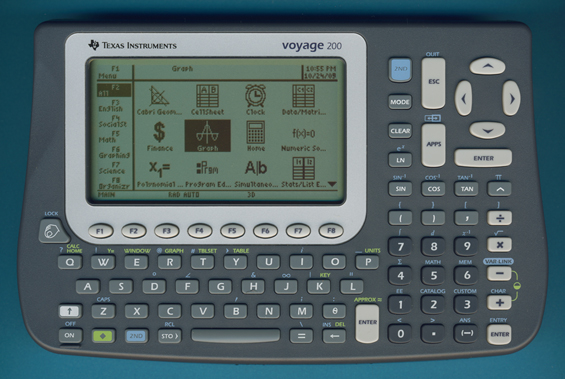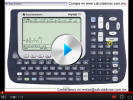
DATAMATH CALCULATOR MUSEUM
 |
DATAMATH CALCULATOR MUSEUM |
Texas Instruments Voyage 200
| Date of introduction: | Jan.6, 2002 | Display technology: | LCD dot matrix |
| New price: | $199.99 (SRP 2008) | Display size: | 12 lines by 40 char 128 * 240 pixels |
| Size: | 4.6" x 7.3" x
1.1" 117 x 185 x 27 mm3 |
||
| Weight: | 9.6 ounces, 272 grams | Serial No: | 1040005591 |
| Batteries: | 4*AAA + CR1616 | Date of manufacture: | mth 06 year 2002 (A) |
| AC-Adapter: | Origin of manufacture: | Taiwan (I) | |
| Precision: | 14 | Integrated circuits: | CPU: MC68SEC000 ASIC: TI REF 200C040 Flash: LH28F320 RAM: 2* CY62128 Display: 3*T6B07, 2*T6B08 |
| Memories: | |||
| Program steps: | 188k Bytes, 2.7M Bytes Flash ROM | Courtesy of: | Joerg Woerner |


![]() At
first glance the stylish Voyage 200 looks like a modern and innovative Symbolic
calculator. Dismantling the calculator reveals a 6 years old design in new
clothes!
At
first glance the stylish Voyage 200 looks like a modern and innovative Symbolic
calculator. Dismantling the calculator reveals a 6 years old design in new
clothes!
We wrote January 5, 1996 when Texas Instruments released with the TI-92 their first Symbolic calculator using a powerful 16/32-bit microcomputer, a full ASCII keyboard, a wide graphics screen and tons of built in software. The TI-92 received since its introduction two upgrades:
TI-92 II: Language selectable Operating System and 128k Bytes additional User memory.TI-92 Plus: Flash ROM technology for re-programmable Operating System and downloadable applications.
 The printed circuit board
(PCB) of this early Voyage 200 manufactured in June 2002 makes use of the TI-92 Plus hardware, but doubles the
capacity of the Sharp
LH28F320 Flash ROM from 1Mx16 Bits (2M Bytes) to 2Mx16 bits (4M Bytes).
The printed circuit board
(PCB) of this early Voyage 200 manufactured in June 2002 makes use of the TI-92 Plus hardware, but doubles the
capacity of the Sharp
LH28F320 Flash ROM from 1Mx16 Bits (2M Bytes) to 2Mx16 bits (4M Bytes).
The main components of the featured Voyage 200 manufactured in June 2002:

 CPU
(Central processing Unit): The
Motorola MC68SEC000
- the original M68000 16/32-bit microprocessor introduced in 1979 - optimized
for embedded applications is supported by the TI-REF 200C040 and replaces the Application
Specific CPU SC414181
solution if the TI-92. Learn more about the Hardware Architecture of TI’s Graphing Calculators.
CPU
(Central processing Unit): The
Motorola MC68SEC000
- the original M68000 16/32-bit microprocessor introduced in 1979 - optimized
for embedded applications is supported by the TI-REF 200C040 and replaces the Application
Specific CPU SC414181
solution if the TI-92. Learn more about the Hardware Architecture of TI’s Graphing Calculators.
 ROM (Read Only Memory): The ROM contains the operating
system of the calculator. The first products on the market used
mask-programmable ROM, the program was stored already during the production
of the Integrated Circuit. Later calculators changed to Flash ROM, a
technology allowing the programming of the software during the final production
stage of the calculator. With the TI-83 Plus and all later graphing calculators
from Texas Instruments even the user was able to reprogram the operating system.
ROM (Read Only Memory): The ROM contains the operating
system of the calculator. The first products on the market used
mask-programmable ROM, the program was stored already during the production
of the Integrated Circuit. Later calculators changed to Flash ROM, a
technology allowing the programming of the software during the final production
stage of the calculator. With the TI-83 Plus and all later graphing calculators
from Texas Instruments even the user was able to reprogram the operating system.
The
Flash ROM chip
LH28F320
of this Voyage 200
was manufactured by Sharp, Japan. The capacity of the memory chip is 2Mx16 bits, or the equivalent of
4M Bytes.
![]() RAM
(Random Access Memory): The RAM is used as data memory and is used to store both
variables, user programs and intermediate results. This Voyage
200
makes use of two Static RAM chips CY62126
manufactured by Cypress, USA. The capacity of the memory chips is
128k Bytes, each.
RAM
(Random Access Memory): The RAM is used as data memory and is used to store both
variables, user programs and intermediate results. This Voyage
200
makes use of two Static RAM chips CY62126
manufactured by Cypress, USA. The capacity of the memory chips is
128k Bytes, each.
 DISPLAY:
The Voyage 200 uses - in opposite to the handheld
graphing calculators from this era - display drivers in conventional packages.
We noticed in this Voyage 200 three T6B07
column drivers and two T6B08 row
drivers manufactured by Toshiba,
Japan.
DISPLAY:
The Voyage 200 uses - in opposite to the handheld
graphing calculators from this era - display drivers in conventional packages.
We noticed in this Voyage 200 three T6B07
column drivers and two T6B08 row
drivers manufactured by Toshiba,
Japan.
A serial port of the calculators allows the connection to the Calculator-Based
Laboratory system CBL, its successor CBL
2 and the Calculator-Based Ranger CBR. Texas
Instruments announced June 2002 an
optional full-sized QWERTY Keyboard for a more
convenient entry of notes into the handhelds but it even matched the
Voyage 200.
![]() Within
the long history of TI calculators between 1972 (the famous Datamath)
and today (June 2003) we never discovered a nameplate without the leading
TI-XXXXXXX designation.
Even the engineers of Texas Instruments were surprised when marketing decided
for the unusual Voyage 200 name!
Within
the long history of TI calculators between 1972 (the famous Datamath)
and today (June 2003) we never discovered a nameplate without the leading
TI-XXXXXXX designation.
Even the engineers of Texas Instruments were surprised when marketing decided
for the unusual Voyage 200 name!
(February 2009: Don't miss this TI-XXXXXXXXXXX,
you are right: 11 X vs 7 X.)
Find the Voyage 200 specification from TI's advertisment:
• Modern and ergonomic design.
• Intuitive icon desktop for easy navigation and organization of Handheld
Software Applications (Apps).
• Built-in clock to keep track of time and date and to use for timing
experiments.
• Full QWERTY keyboard, numeric keypad.
• 128 x 240 pixel display.
• About 188K bytes of user-available RAM.
• About 2.7 MB of user-available FLASH ROM (3x the FLASH ROM memory of the
TI-92 Plus).*
• Electronic upgradability of software including maintenance and feature
upgrades.
• Advanced Mathematics Software functionality suitable for college
mathematics and engineering coursework.
• Pretty Print shows equations and results with radical notation, stacked
fractions, and superscript exponents.
• Active Calculator Home history screen can hold up to 99 previous entries
for deep recall.
• Interactive geometry applications for Euclidean, transformational, and
analytic geometry explorations (based on Cabri Geometry II).
• Real and complex numeric results.
• Symbolic manipulation for algebra, calculus and differential equations.
• Symbolic units for use in equations, computations, and unit conversions.
Over 100 units in 28 unit categories. 20 constants with symbolic units.
• Graphs functions, parametric and polar equations, recursively-defined
sequences, 3-dimensional surfaces, and differential equations.
Up to 99
graphing equations defined and saved for each graphing mode.
• Numeric evaluation of functions in tables and data variable format.
• Interactive analysis of function values, roots, maximums, minimums,
integrals, derivatives, intersections, inflection points, and arc lengths.
• Recursively-defined sequences access any number of previous terms.
• Slope and direction fields for exploring differential equations. RK and
Euler numeric differential equation solving methods.
• Real time rotation of 3D surfaces.
• List-based one- and two-variable statistical analysis, including eight
regression models.
• Statistics plots including scatter, xy-line, box and modified box plots.
Histograms and regression lines.
• Matrix operations including inverse, determinant, transpose, augment,
elementary row operations, and reduced row echelon form.
Matrix elements can
be real or complex and numeric or symbolic.
• Advanced matrix operations including eigenvalues, eigenvectors, LU and QR
decompositions.
• Column-logic expressions in data/matrix editor are retained for automatic
recalculation when values change.
• Interactive numeric equation solver.
• Hexadecimal and binary operations and conversions.
• Extensive programming capability with number and size of programs limited
only by available memory. User-definable functions extend built-in
functionality.
• Optional assembly language programming.
• Command catalog screen to access and show "help" information for
each function and command.
•
Memory management to create folders for specific applications or subjects.
• 255 symbols in the character set including Greek, system, and
international characters.
•
Compatible with Calculator-Based Laboratory™ (CBL2™) and
Calculator-Based Ranger™ (CBR™) Systems to allow analysis of real-world
data.
• Link capabilities for data transfer through I/O port. USB and unit-to-unit
link cables included.
•
ViewScreen™ overhead port.
• Powered by 4 AAA batteries with lithium battery backup to protect memory
during main battery change.
•
One-year limited warranty.
• Toll-free help hot-line
• e-mail help line: ti-cares@ti.com.
• Volume Purchase Program.
• Activity Books.
• Workshop Loan Program – borrow calculators for evaluation of workshops.
• Printed Getting Started Guide included, full Guidebook available on
Resource CD.
• Pre-installed applications
Courtesy of Texas Instruents: http://www.ti.com
 Don't
miss the Tutorial for the Voyage 200 calculator on YouTube prepared by
Cómputo Numérica, the
first online store specialized in calculators in Latin America.
Don't
miss the Tutorial for the Voyage 200 calculator on YouTube prepared by
Cómputo Numérica, the
first online store specialized in calculators in Latin America.
Courtesy of Cómputo Numérica:
http://www.calculadoras.com.mx
ROM-Versions:
2.06
2.07
2.08 (July 29, 2002, recalled and re-released February 20, 2003)
2.09 (March 27, 2003)
3.00
3.01 (October 7, 2004)
3.10 (July 18, 2005, actual in February 2008)
You can check the ROM version of your
Voyage 200 using the following key
sequence and reading the number on your screen:
[F1] [A]
Information provided by ticalc.org
and Xavier Andréani.
Exam acceptance:
Since the TI-92 Series and Voyage 200
feature a QWERTY keyboard they are not allowed on ACT,
SAT, PSAT
and AP exams.
| Texas
Instruments Unveils Next Generation Educational Handheld
Voyage™ 200 delivers increased memory, functionality and portability DALLAS, January 6, 2002
|
||||||||||||||||||||||||||||||||||||||||
If you have additions to the above article please email: joerg@datamath.org.
© Joerg Woerner, June 8, 2003. No reprints without written permission.